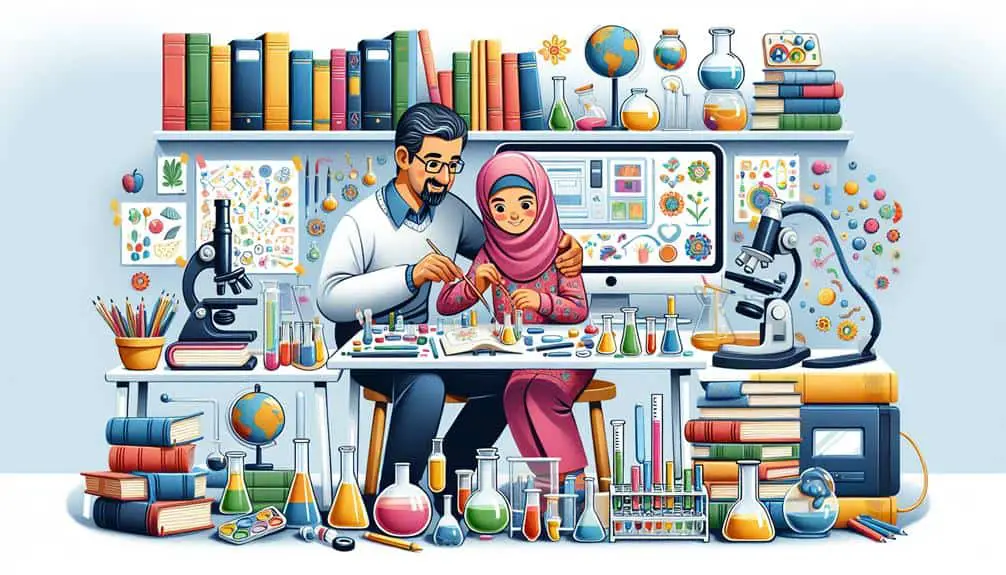Homeschooling twice-exceptional gifted children successfully involves tailoring their education to fit their unique needs. Understand their challenges and strengths, use technology like adaptive tools, create a supportive environment, and balance structured learning with free time. By addressing sensitivities, you can nurture their talents effectively. Remember, fostering their growth mindset and encouraging exploration are key. Each child is different, so adapting the learning approach is vital. With the right strategies, you can support your child's development and academic success in a homeschool setting.
Key Points
- Personalized learning plans cater to strengths and challenges.
- Utilize adaptive technology for individualized instruction.
- Balance structured lessons with flexible exploration time.
- Encourage growth mindset and celebrate achievements.
- Foster parental involvement and open communication.
Understanding Twice-Exceptional Giftedness
You may find it helpful to understand that twice-exceptional giftedness refers to individuals who are gifted yet also have learning or developmental challenges. Being aware of giftedness in this scenario means recognizing the unique strengths and abilities these individuals possess alongside their struggles. Educational accommodations play a significant role in supporting twice-exceptional children in their learning journey. By acknowledging their giftedness and challenges, you can create a nurturing environment that caters to their specific needs.
Giftedness awareness involves recognizing the intellectual capabilities and talents of these children while also understanding the hurdles they face due to their learning or developmental issues. It's vital to approach their education with empathy and patience, considering both their exceptional abilities and areas where they may require additional support.
Educational accommodations are tailored strategies or adjustments in the learning environment to help twice-exceptional gifted children thrive academically. These accommodations can include personalized learning plans, modified assignments, flexible scheduling, or specialized resources to address their unique needs effectively. By implementing these accommodations, you can create an inclusive and supportive educational experience that allows these children to reach their full potential.
Tailoring Curriculum to Individual Needs
Tailoring curriculum to meet the individual needs of twice-exceptional gifted children is an essential aspect of providing them with a supportive and enriching educational experience. Personalized instruction plays an important role in ensuring that these children receive the educational content in a way that suits their unique strengths and challenges.
Differentiated learning strategies allow for flexibility in pacing, depth, and method of instruction, catering to the diverse learning styles and abilities of twice-exceptional learners.
When tailoring the curriculum for your twice-exceptional gifted child, it's significant to take into account their specific areas of giftedness and areas where they may need additional support. By understanding their strengths and challenges, you can create a learning plan that nurtures their talents while providing scaffolding in areas where they require assistance.
Embrace a mix of challenging materials that cater to their advanced abilities and supportive resources that help them overcome obstacles they may face.
Implementing Strength-Based Learning
You should focus on nurturing your twice-exceptional gifted child's strengths rather than fixating on weaknesses.
By tailoring their learning experience to highlight their talents, you can create a more engaging and effective educational environment.
Recognizing and supporting their unique abilities will empower them to thrive and reach their full potential.
Strengths Over Weaknesses
How can we effectively implement strength-based learning for twice-exceptional gifted children to emphasize their abilities over challenges?
It's essential to focus on embracing differences and celebrating strengths to nurture potential and build confidence in these unique learners.
- Identify Strengths:
Begin by recognizing and understanding the specific strengths of your twice-exceptional child. This could be in areas such as creativity, problem-solving, or a particular subject they excel in.
- Tailor Learning Activities:
Design learning activities that capitalize on their strengths while still addressing areas of challenge. This approach creates a more engaging and empowering learning environment.
- Encourage Self-Expression:
Provide opportunities for your child to express themselves through their strengths, whether it's through art, writing, or hands-on projects. This boosts their confidence and self-esteem.
- Celebrate Progress:
Acknowledge and celebrate every small achievement and progress made, reinforcing a positive mindset and motivating them to continue growing. Remember, progress is progress, no matter how small.
Individualized Learning Approaches
Identifying and leveraging the unique strengths of twice-exceptional gifted children is foundational to tailoring individualized learning approaches that foster their growth and potential. Personalized instruction plays an essential role in meeting their specific academic and social-emotional needs. By customizing teaching methods to align with their strengths, you create a supportive environment where they can thrive.
Incorporating adaptive technology can further enhance their learning experience. Technology tools can be tailored to their abilities, making learning more engaging and accessible.
Flexible scheduling allows you to adapt to their unique learning rhythms and interests. Embracing creative methods such as project-based learning, hands-on activities, and real-world applications can ignite their passion for learning and enhance their growth.
Talent Recognition and Support
Implementing strength-based learning involves recognizing and nurturing the unique talents and abilities of twice-exceptional gifted children. These individuals possess exceptional gifts alongside challenges, making it important to focus on their strengths for effective learning.
Here are some strategies to support talent recognition and development:
- Gifted advocacy: Championing for the needs and rights of twice-exceptional gifted children is vital in ensuring they receive the support and resources necessary for their growth.
- Strength-based programming: Tailoring educational programs that emphasize the strengths of these children can lead to increased engagement, motivation, and overall success in their learning journey.
- Talent development: Providing opportunities for honing and showcasing their talents can boost the self-esteem and confidence of twice-exceptional gifted children, empowering them to thrive academically and socially.
- Student empowerment: Encouraging autonomy and self-advocacy skills in these students can help them navigate challenges effectively and take ownership of their learning experiences.
Addressing Challenges With Sensitivity
To support twice-exceptional gifted children effectively, it's essential to approach and tackle their unique challenges with sensitivity and understanding. Parental support plays a pivotal role in creating a safe and nurturing environment for these children. Being attuned to their emotional needs and providing a supportive network can help them navigate their dual exceptionalities with confidence.
Understanding and accommodating their learning styles is key. Each child is unique, and tailoring educational approaches to suit their individual needs can make a significant difference. Emotional intelligence is important in recognizing when a child may be feeling overwhelmed or frustrated, allowing for timely intervention and support.
Creating a homeschooling environment that's flexible and responsive to their needs is crucial. Providing accommodations such as extended time for assignments or alternative methods of assessment can help alleviate some of the pressures these children may face.
Utilizing Assistive Technology Tools
When supporting twice-exceptional gifted children in their homeschooling journey, incorporating assistive technology tools can enhance their learning experience and cater to their specific needs effectively. Here are some ways you can integrate tech tools to create a personalized learning environment for your child:
- Tech Integration: Utilize educational apps and online platforms tailored to your child's strengths and weaknesses. These tools can provide interactive lessons and activities that explore their pace of learning.
- Adaptive Tools: Explore adaptive technologies such as text-to-speech software, speech recognition programs, or audiobooks to assist children with learning disabilities while nurturing their gifted abilities.
- Customized Learning: Use educational technology to customize lesson plans and materials based on your child's unique learning style and interests, allowing them to investigate deeper into subjects that captivate their curiosity.
- Interactive Learning: Incorporate tools like virtual reality simulations or educational games to make learning engaging and fun, promoting active participation and enhancing retention of information.
Fostering a Supportive Learning Environment
Enhancing the learning journey for twice-exceptional gifted children in a homeschool setting involves cultivating a nurturing and supportive environment that fosters their growth and development. Parent involvement is key; by actively participating in your child's education, you can provide the necessary support and encouragement tailored to their unique needs.
Engage in open communication, listen attentively, and adapt teaching methods to suit their learning style.
Flexibility in scheduling is essential for twice-exceptional gifted children. Allow room for breaks, exploration, and in-depth exploration into subjects that spark their interest. Establishing a routine that balances structured learning with free time can help maintain focus and prevent burnout.
Create a physical learning space that's conducive to concentration and creativity. Personalize it with their favorite books, tools, and resources. Encourage a growth mindset, celebrating achievements and embracing mistakes as opportunities for learning.
Frequently Asked Questions
How Can I Balance Remediation and Advanced Learning for 2e Gifted Children?
You want to find balance for 2e gifted kids? Start with personalized learning. Mix in targeted interventions. Embrace individualized approaches that cater to both remediation and advanced learning. It's a unique journey, but you've got this.
What Are Effective Ways to Support Social-Emotional Needs in 2e Homeschooling?
Supporting social-emotional needs in 2e homeschooling, consider incorporating mindfulness activities for emotional regulation. Encourage peer support for developing social skills. Creating a safe space where your child feels understood and nurtured is crucial.
Is It Possible to Incorporate Talent Development While Addressing Weaknesses?
Balancing talent cultivation and weakness management in homeschooling isn't just doable; it's essential for holistic growth. Like a gardener nurturing flowers, you can foster strengths while gently tending to areas needing extra care.
How Can I Adapt Teaching Methods for 2e Children With Sensory Issues?
When teaching 2e children with sensory issues, it's essential to make sensory accommodations, offer individualized learning, utilize a multi-sensory approach, and have flexibility in the curriculum. By adapting to their needs, you can create a supportive learning environment.
What Are Practical Ways to Collaborate With Professionals in 2e Education?
Listen closely to those who understand. Collaborating with therapists and educators opens doors to tailored strategies. Seek professional guidance, embrace their resources. Together, you'll navigate the unique terrain of 2e education.



